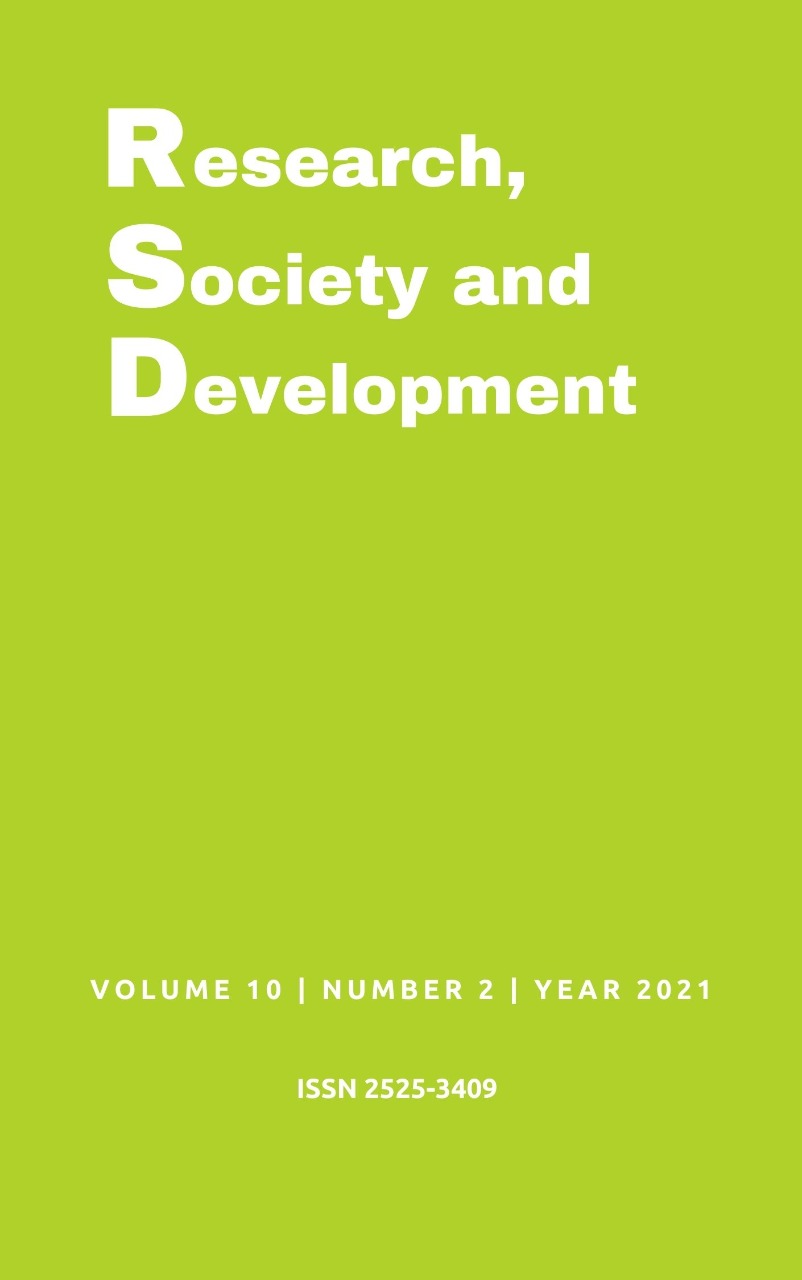Contribuições da simulação realística no ensino-aprendizagem da enfermagem: revisão integrativa
DOI:
https://doi.org/10.33448/rsd-v10i2.12841Palavras-chave:
Simulação, Educação em Enfermagem, Ensino, Aprendizagem.Resumo
O objetivo deste estudo foi analisar a contribuição da simulação realística do ensino de graduação em Enfermagem. Trata-se de um estudo de revisão integrativa, com abordagem qualitativa, com dados coletados por meio da busca de artigos anexados nas bases de dados referentes à Biblioteca Virtual em Saúde e Literatura Latino-Americana e do Caribe em Ciências da Saúde. A combinação dos descritores na pesquisa foi de simulação ou treinamento por simulação e enfermagem, e período de busca foi realizado de janeiro a março de 2020. O total de material bibliográfico dessa revisão foi de 34 artigos. A maioria dos artigos são de natureza metodológica, e método de pesquisa com instrumento avaliativo de pré e pós teste com prática. As principais vantagens citadas pelos periódicos em relação à utilização da simulação realística foram: facilitar o conhecimento; autoconfiança e precisão; aproximação da realidade e raciocínio clínico. Esse estudo demonstrou que a simulação realística em enfermagem, vem se tornando um instrumento-chave e inovador de aprendizado. É uma ferramenta capaz de favorecer a retenção do conhecimento com o desenvolvimento de raciocínio clínico, segurança e precisão nas habilidades.
Referências
Barreto, D. G., Silva, K. G. N., Moreira, S. S. C. R., Silva, T. S., & Magro, M. C. S. (2014). Simulação realística como estratégia de ensino para o curso de graduação em enfermagem: revisão integrativa. Revista Baiana de Enfermagem, 28(1), 208-214.
Dal Sasso, G. M., Sebold, L. F., Kempfer, S. S., & Oliveira, S. N. (2015). Guia metodológico para simulação em enfermagem – CEPETEC. https://nfr.ufsc.br/files/2015/11/GUIA-METODOL%C3%93GICO-PARA-SIMULA%C3%87%C3%83O-EM-ENFERMAGEM-CEPETEC.pdf
Fabri, R. P., Mazzo, A., Martins, J. C. A., Fonseca, A. S., Pedersoli, C. E., Miranda, F. B. G., & Baptista, R. C. N. (2017). Construção de um roteiro teórico-prático para simulação clínica. Revista da Escola de Enfermagem da USP, 51, e03218.
Ferreira, C., Carvalho, J. M., & Carvalho, F. L. Q. (2015). Impacto da metodologia de simulação realística, enquanto tecnologia aplicada a educação nos cursos de saúde. Anais do Seminário Tecnologias Aplicadas a Educação e Saúde, 1(1), 32-40.
Melo, M. C. B., Magalhaes, A. M. P. B., Silva, N. L. C., Liu, P. M. F., Cerqueira Filho, L. C., & Santos, A. F. (2016). Ensino mediado por técnicas de simulação e treinamento de habilidades de comunicação na área da saúde. Revista Médica de Minas Gerais, 26, e-1805.
Miranda, F. B. G., Mazzo, A., & Pereira Junior, G. A. (2018). Uso da simulação de alta fidelidade no preparo de enfermeiros para o atendimento de urgências e emergências: revisão da literatura. Sci. med. (Porto Alegre, Online), 28(1), ID28675.
Oliveira, S. N., Massaroli, A., Martini, J. G., & Rodrigues, J. (2018). Da teoria à prática, operacionalizando a simulação clínica no ensino de Enfermagem. Revista Brasileira de Enfermagem, 71(Suppl. 4), 1791-1798.
Roman, A. R., & Friedlander, M. R. (1998). Revisão integrativa de pesquisa aplicada à enfermagem. Cogitare Enferm., 3(2), 109-112.
Salvador, P. T. C. O., Martins, C. C. F., Alves, K. Y. A., Pereira, M. S., Santos, V. E. P., & Tourinho, F. S. V. (2015). Tecnologia no ensino de enfermagem. Revista Baiana de Enfermagem, 29(1), 33-41.
Santos, M. C., & Leite, M. C. L. (2010). A avaliação das aprendizagens na prática da simulação em Enfermagem como feedback de ensino. Revista Gaúcha de Enfermagem, 31(3), 552-556.
Sebold, L. F., Böell, J. E. W., Girondi, J. B. R., & Santos, J. L. G. (2017). Simulação clínica: desenvolvimento de competência relacional e habilidade prática em fundamentos de enfermagem. Rev enferm UFPE on line, 11(Supl. 10), 4184-4190.
Serapioni, M. (2000). Métodos qualitativos e quantitativos na pesquisa social em saúde: algumas estratégias para a integração. Ciência & Saúde Coletiva, 5(1), 187-192.
Silva, D. A., Almeida, C. L., Capellini, V. K., & Silva, R. G. (2020). Educação em enfermagem: criação de uma liga acadêmica para o ensino de urgência e emergência. Research, Society and Development, 9(3), e159932656. https://doi.org/10.33448/rsd-v9i3.2656
Soares, C. B; Hoha, L. A. K; Peduzzi, M., Sangaleti, C., Yonekura, T., & Silva, D. R. A. D. (2014). Revisão integrativa: conceitos e métodos utilizados na enfermagem. Rev Esc Enferm USP, 48(2):335-45.
Yamane, M. T., Machado, V. K., Osternack, K. T., & Mello, R. G. (2019). Simulação realística como ferramenta de ensino na saúde: uma revisão integrativa. Espaço para Saúde, 20(1).
Downloads
Publicado
Edição
Seção
Licença
Copyright (c) 2021 Isabella Domingues; Eleine Martins; Caroline Lourenço de Almeida; Daniel Augusto da Silva

Este trabalho está licenciado sob uma licença Creative Commons Attribution 4.0 International License.
Autores que publicam nesta revista concordam com os seguintes termos:
1) Autores mantém os direitos autorais e concedem à revista o direito de primeira publicação, com o trabalho simultaneamente licenciado sob a Licença Creative Commons Attribution que permite o compartilhamento do trabalho com reconhecimento da autoria e publicação inicial nesta revista.
2) Autores têm autorização para assumir contratos adicionais separadamente, para distribuição não-exclusiva da versão do trabalho publicada nesta revista (ex.: publicar em repositório institucional ou como capítulo de livro), com reconhecimento de autoria e publicação inicial nesta revista.
3) Autores têm permissão e são estimulados a publicar e distribuir seu trabalho online (ex.: em repositórios institucionais ou na sua página pessoal) a qualquer ponto antes ou durante o processo editorial, já que isso pode gerar alterações produtivas, bem como aumentar o impacto e a citação do trabalho publicado.


